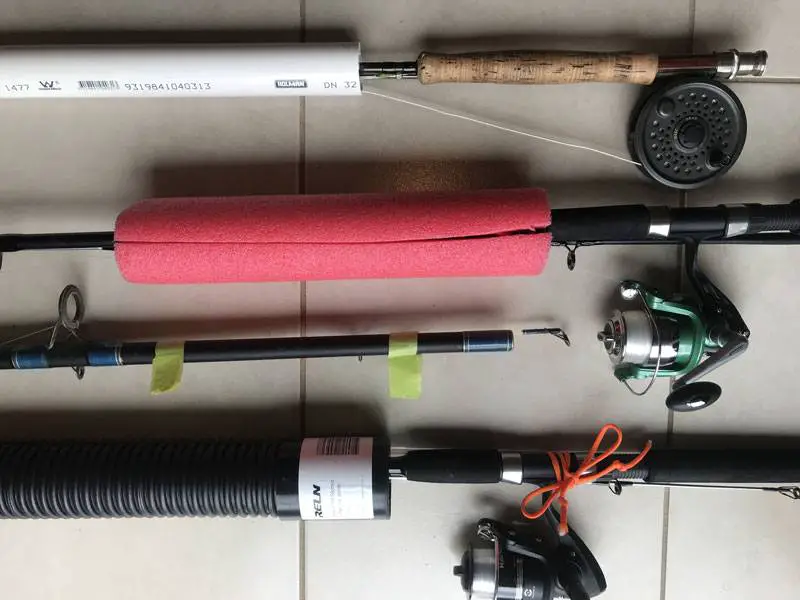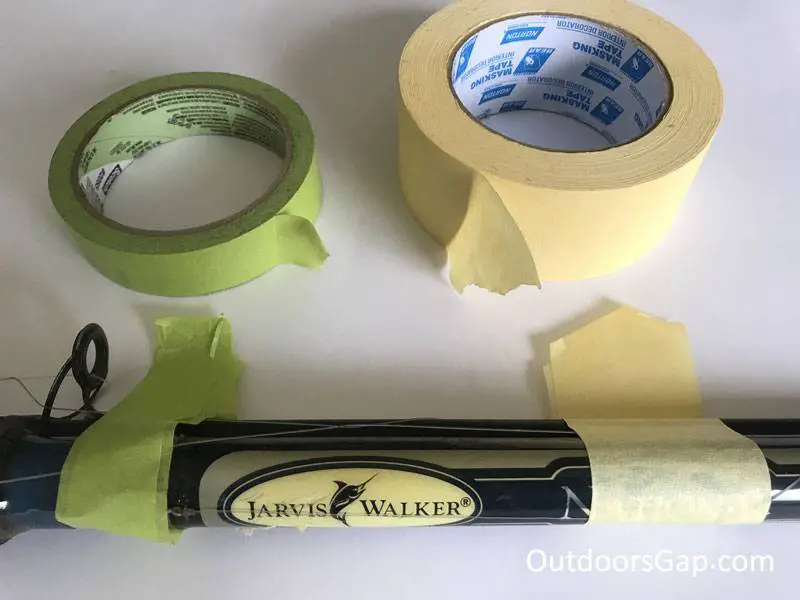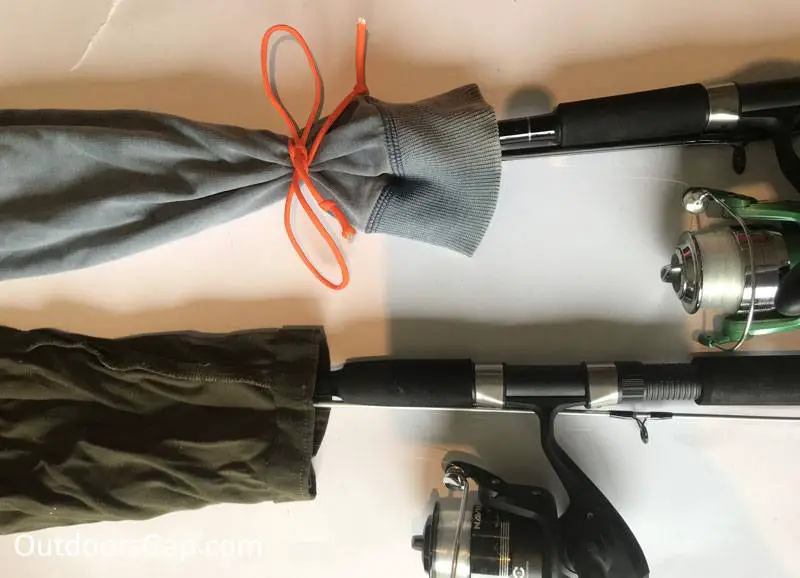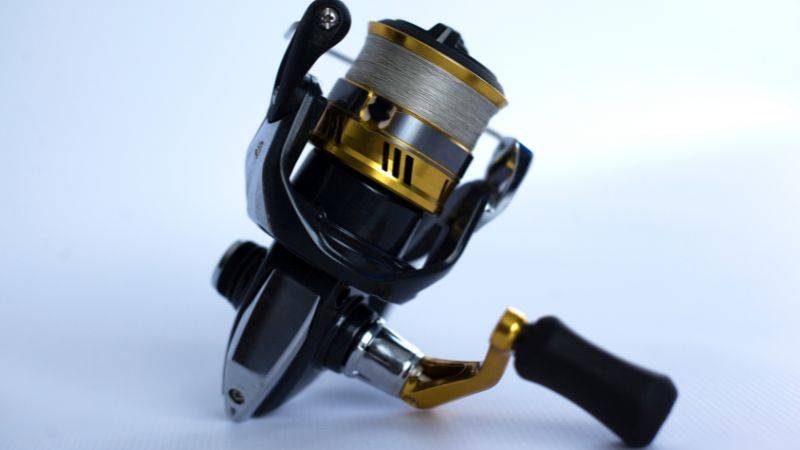You arrive at your spot all excited to start fishing, you get the rods out of the back of the vehicle and guess what? Line is everywhere, hooks catching on things and it will take at least twenty minutes to untangle your fishing gear.
(Bad tangles always seem to happen when the fish are jumping or biting.)

So, we have come up with some cheap tangle free solutions, so that you can still keep your rods rigged up when travelling, but still ready to go.
How To Keep Fishing Rods From Tangling
Here are 7 easy DIY ways to keep your rods tangle free when travelling.
- Painters tape

Painters tape is an easy solution of keeping two piece fishing rods tangle free.
You can place two or three tape sections over the rod. Place some over where the hook is. Also the sinker (fishing weight) is worth taping over, so it doesn’t rattle or bang the rod when travelling.
Tip – When you use a piece of tape, make one end longer and tape over itself. So you can separate the pieces quickly and easy to unwrap.
Painters tape is cheap and depending how often you go fishing a roll should last a fair few fishing seasons.
You can even tape up individual rods with it, then tape two or three rods together with it.
The disadvantage is that some (especially the cheap brands) brands of tape can damage the rods surface. Especially if you leave the rods in a hot car, which ideally you shouldn’t keep the rods in a hot vehicle.
While painters tape is gentle on surfaces, if you leave it on for a long time, it can be sticky.
Another negative is that normally you can only get one or two uses out of a piece.
Masking tape can also be used as well, but the painters tape seems gentler on the rods.
Use painters tape on hand reels as well.

Painters tape is an easy way to secure your lines and hooks when transporting your rods.
- Velcro
Another cheap and easy DIY solution for tangled rods is some Velcro tape sections.
Use two or three sections of Velcro around a foot length (30 cm) or less to wrap around the rods when travelling.
I use this method for my bait and fly rods some times.
- Pool Noodle

Swimming pool noodles have 101 uses for fishing.
You can use them to wrap fishing line leaders and hooks on them, place lures in them, use them as makeshift floats. I have used them to place over a landing net handle, so it will float if dropped overboard.
When kayak fishing, use a piece so if the rod goes overboard it will float. Tether some cord from the rod, to a section of short pool noodle.
But for this article we will use the swimming pool noodle to place over the rod and lines when transporting the rods.
(The pool noodle should be the hollow ones.)
Cut down the pool noodle length ways. Use it to place over the rods and lines.
One long piece or two pieces can be used.
For thicker fishing rods, like saltwater big game rods, you might have to cut a strip lengthwise out, to accommodate for the fatter rods.
You can use the noodles in the boat as well as the foam is waterproof from the boat spray.
As well as stopping the lines from tangling together with other rods, the foam noodle also protects the rods from banging together.
Place a foam section over the hook to keep the hook secure as well. This is also safer than an exposed hook in the back of the vehicle or boat.
Instead of a pool noodle, plumbing foam pipe wraps like the ones from Bunnings work well. Speaking of Bunnings they have some unexpected camping gear and outdoor stuff. For more information, click on – Bunnings Camping Gear
I put some plumbing foam pipe over my landing net for kayak fishing, so if I accidentally drop the net over board it will float.
- PVC Pipe Fishing Rod Tube

PVC pipe is another easy method to keep your rods separated and tangle free.
As well as tangle free lines, the pipe also protects the rod tips from items falling on it when traveling.
(You can also buy fishing rod tube holders from fishing shops.)
Cut out a section out of the pipe for the reel. (A metal hand saw works well.) Mark the line you want cut out with a sharpie or tape.
Optional is to place a plug or cap on one end. You can get screw on section or slip on caps for the pipes.
If you want to fancy the rod holder up. You can spray paint it. Or you can a cloth sock cover that goes over the tube.
The PVC pipe is also a good way for travelling to longer fishing trip destinations, where you might take your reel and terminal tackle off the rod.
(The PVC pipe rod protector is a good one for traveling with kids. As it stops them from accidentally damaging the tips of the rods when getting gear out of the vehicle.)
One disadvantage of the PVC rod holder is that it doesn’t cover or protect the fishing reel.
Building the PVC rod tube case is a good project to do with your children who like fishing.
Kids can write their name on it, paint it for a personal rod case. Or put all the fishing tackle stickers on it, like; Shimano, Shakespeare Rods, Loomis, Sage, Penn, etc.
Ag pipe can also be used as a tube holder.
The PVC tube is also a good option when storing the fishing rods at home as well as it keeps most of the rod protected.
To stop the rod sliding out, place a rubber (elastic) band near the back of the reel foot and reel over the PVC tube.
- Home Made DIY Cloth Fishing Rod Sock

Most fishermen and fisher ladies have some old clothes lying about, so this one is quick and easy to make. (Or plenty of fishing stores sell rod socks, or get them online.)
For some old clothing, cut a section off the arm piece. Tie a knot in the end of the sleeve or pants leg if you want. Or use some cordage to it on the rod, or to tie the ends.
You can use two pieces or one piece of material. Use arm sections from a top or pants leg material. The pants will cover up the reel easier.
An advantage of the cloth rod sock is that you can make so it covers and protects the fishing reel as well. This stop it from getting bumped and scratched.
One disadvantage is the cloth material can get a hook in it when sliding the rod out. It can also look a bit rough. (But the fish don’t seem to mind when you catch them though.)
Another negative of the rod cloth case is that one jumper sleeve might only cover a short section of the fishing rod. But you can use two pieces of cloth and it stops the lines from tangling the two sections.
The cloth rod sock and rods can also be put inside a section of PVC as well to protect the rod blank further.
If you are into sewing, then a long cloth rod sock can easily be sewn together. Or you can tack on some ribbon to tie off one end.
Be careful if you put a big baggy rod sock in your boat and lay it horizontally down with the rod tip towards the bow, as the wind can catch it and the rod can go flying out of the boat when travelling fast. You definitely don’t want to travel in the boat with the rods stored vertically as the rod sock can catch the wind and snap the rod tip off.
- Paracord

Shoe laces, paracord and other cordage can be used. Just tie / wrap a few turns around the rod and fishing line. Tie with a shoe lace knot with a bow in it, to untie it quickly and easily. Use two or three bits of cordage along the fishing rod.
Place an overhand knot on both ends of the paracord or cordage to stop it fraying.
A bright coloured bit of paracord or cordage is easier to find when you have to take them off and put them back on.
Place the cordage in a spot you know when you take the paracord off, so you can easy find them again. Maybe place them inside of the fishing tackle bag, hatch of the boat, or the side of the car in the boot.
- Ribbons
Other simple ideas for tangle free fishing are to use two or three ribbons to secure the rod and line together.
Just like the paracord, use bright colours so they are easy to find when you take them off the rod.
Other DIY Fishing Rod Covers, Tips And Hacks
For a bigger projects, tape two or three PVC sections parallel together to hold multiple fishing rods when travelling.
For storing rods at home, cut the PVC in half, length wise and screw them to some cross sections. Hang them horizontally from the rafters, or wall in the garage for an easy place to store the rods.
Short sections of rubber or hose tube can also be used for a simple rod separator when travelling.
For travelling long distances in a vehicle or plane, it is best to take the terminal tackle and reels completely off the rod.
Old golfing plastic tubes can also be used to stop the rods from tangling.

An old camping chair cover can also work as a sock / bag for the rod. This wide enough to cover the reel as well. Some bags may not be long enough to cover two broken down sections of rod, but this will still stop the tangles.
You can use a combination of these above DIY methods as well.
If you leave your terminal tackle on, a good idea is to cover the hook up with painters tape any way. You could use the tape over the hook with the fabric sleeves, as the hook can get stuck in the material easy.
As well as the tape keeps things tangle free, it also stops the sinkers from rattling while travelling.
Commercial hook bonnets that go over the hook are another option to stop the hooks snagging items. These are very good for treble hooks and lures in the boat or car as well. Years ago, before hook bonnets were available, I used old film canister or little round plastic containers and cut a slit in them to go over the treble hook.
Rubber bands, or elastic bands can go over the rod butt and rod tip to hold a two piece rod together.
Be careful with the runners and rod tips, using the different methods, as they can be fragile on some rods, like fly rods.
The above methods may not protect your rod when travelling like a commercial hard rod tube or case, but they are good ways to stop the rods getting tangled when travelling.
Some of these projects are great to get the kids involved in as well, if they enjoy fishing.

Above photo: An easy way to transport fishing rods, tangle free with a camping chair cover. Fishing location at Patterson River in Victoria.
Summary
Using these methods are easy DIY projects that are cheap and work well keeping the rods untangled.
Of course you can always disconnect your terminal tackle from the rod, but that takes up valuable fishing time when setting it up again. So the tangle free rod and lines ideas are quick and easy to make and use.
The best way to transport the fishing rods tangle free, might be a combination of two methods. Like painters tape and a rod sock. Or fishing rod sock and some PVC tubing for travelling and storage.
We hope you enjoyed these ways on how to keep your fishing rods tangle free when travelling.
Remember to take all you rubbish home with you when fishing, (like the painters tape) do the right thing and follow the fishing regulations. This helps future generations to experience fishing and being outdoors.
Good luck fishing and hope to see you at the water’s edge with some big fish.



